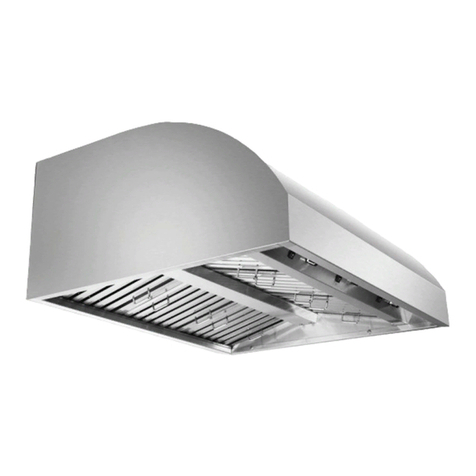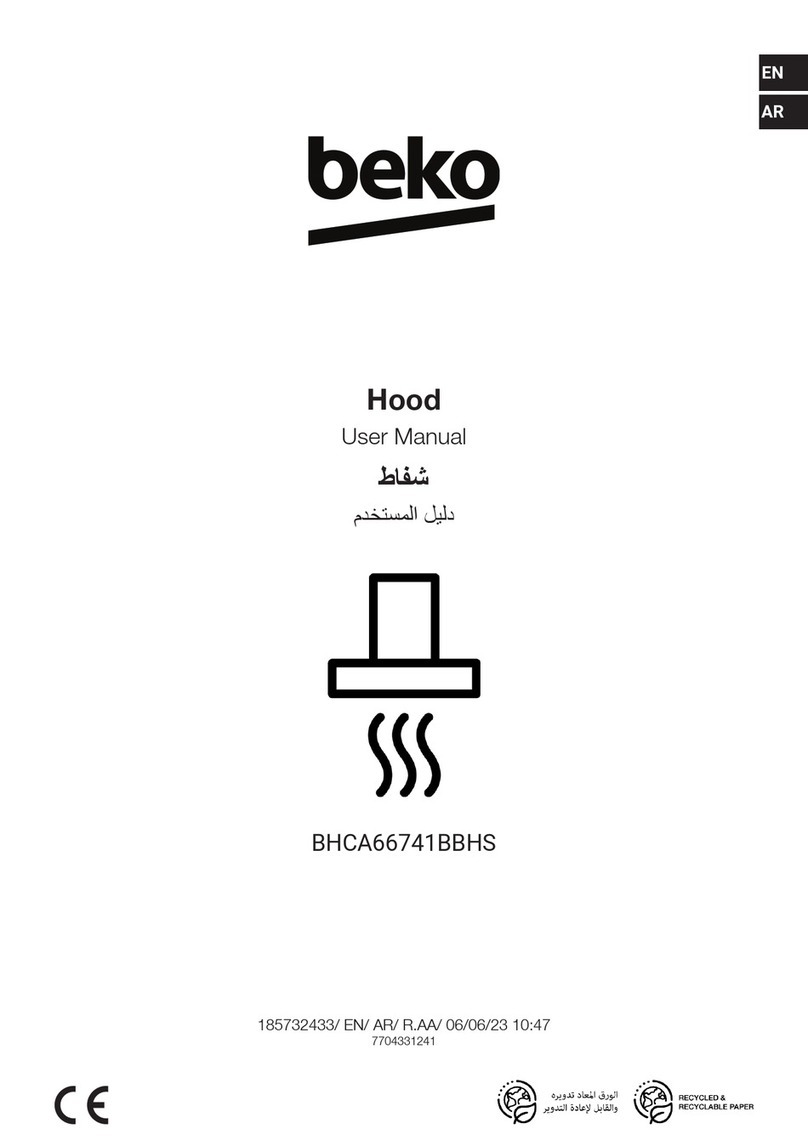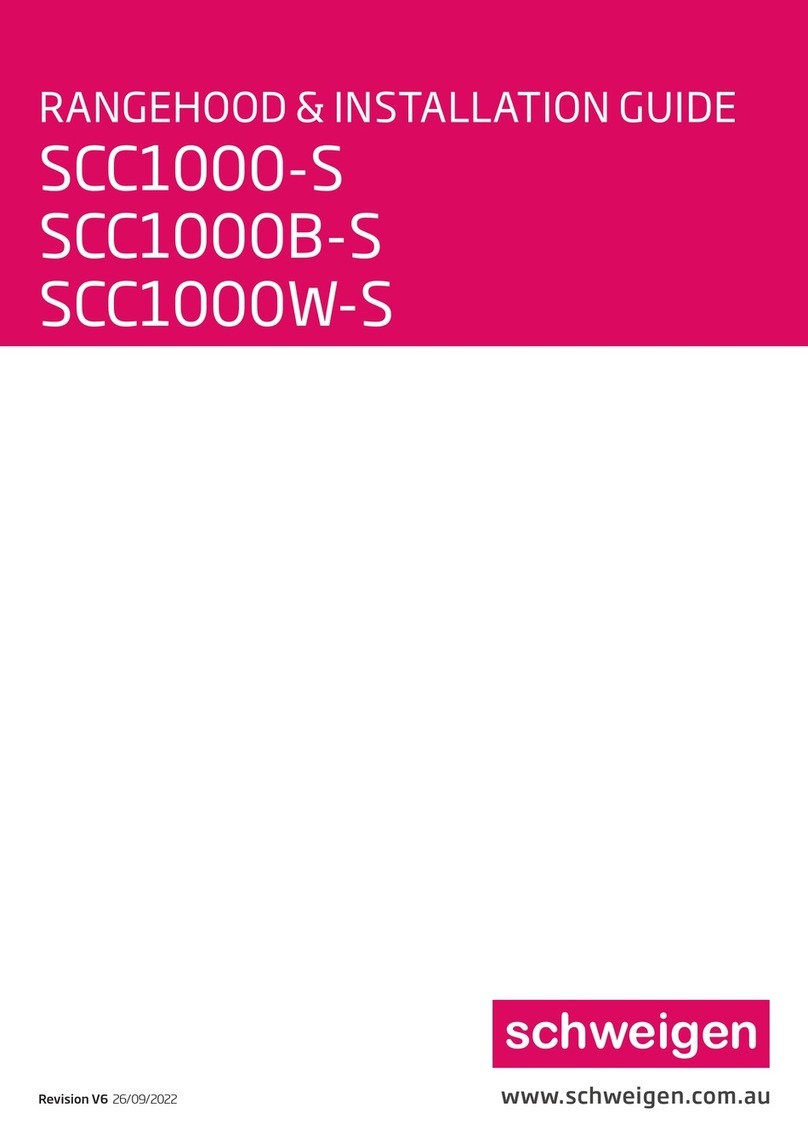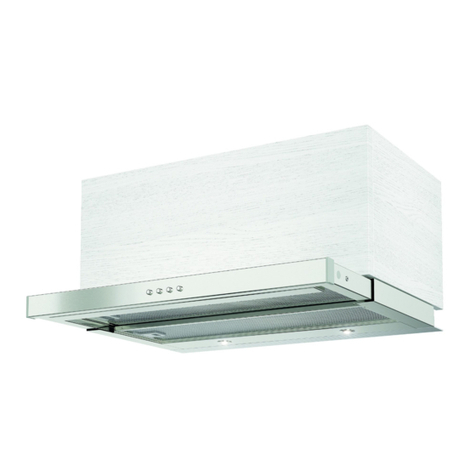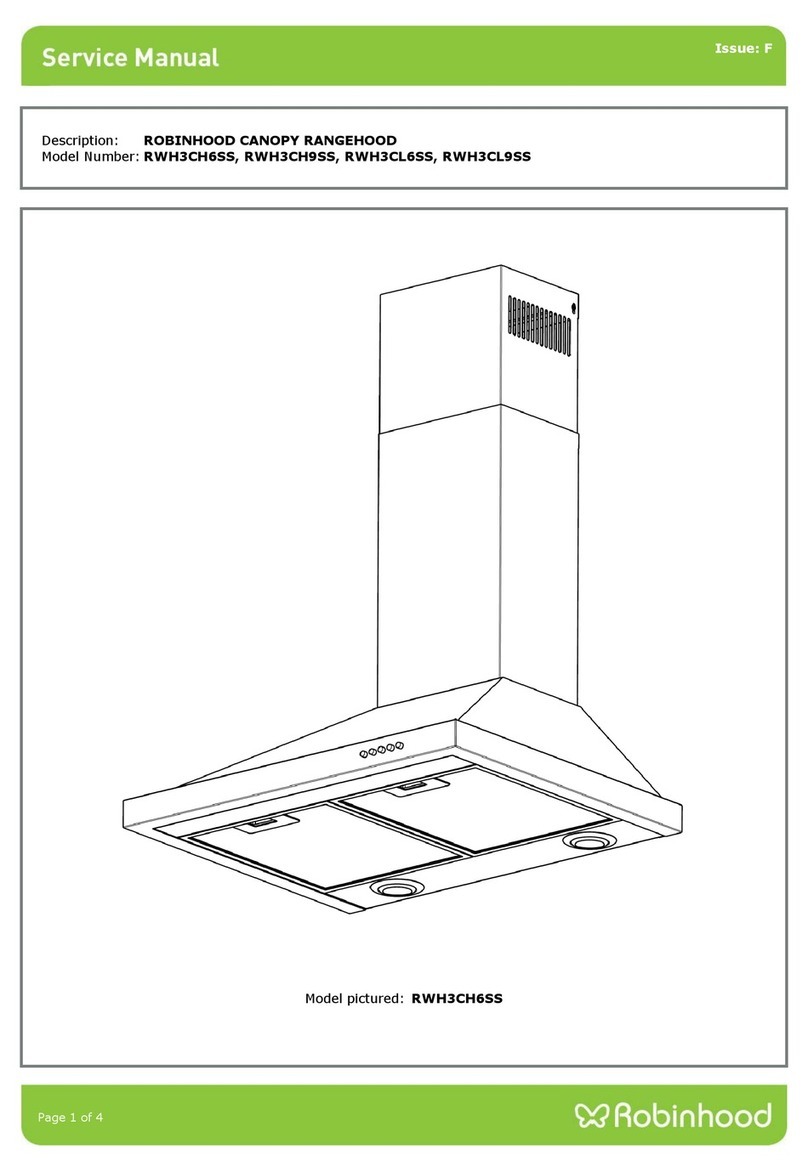EuroKitchen AirPRO 238 Professional Series Assembly instructions

Installation Guide
and Users Manual
Wall Mount Range Hood
AirPRO 238 Professional Series (PS29/PS31)
IMPORTANT:
Read and save these instructions.
NOTICE:
Installer: Leave this guide with the homeowner
Homeowner: Keep this guide for future reference


Important Safety Notice
Read all Instructions before Installing and operating this appliance
The installation in this manual is intended for qualified installers, service technicians or persons with•
similar qualified background. Installation and electrical wiring must be done by qualified profession-
als and in accordance with all applicable codes and standards, including fire-rated construction.
DO NOT• attempt to install this appliance yourself. Injury could result from installing the unit due to
lack of appropriate electrical and technical background.
Range hood may have very sharp edges; please wear protective gloves if it is necessary to remove any•
parts for installing, cleaning or servicing.
Activating any switch ON before completing installation may cause ignition or an explosion.•
Due to the size and weight of this range hood, two people installation is recommended.•
To reduce the risk of fire, electric shock, or injury to persons:
For general ventilating use only.• DO NOT use to exhaust hazardous or explosive materials and va-
pors.
The combustion air flow needed for safe operation of fuel-burning equipment may be affected by this•
unit’s operation. Follow the heating equipment manufacturer’s guideline and safety standards such
as those published by the National Fire Protection Association (NFPA), and the American Society of
Heating, Refrigeration and Air Conditioning Engineers (ASHRAE), and the local code authorities.
Before servicing or cleaning unit, switch power OFF at service panel and lock service panel to pre-•
vent power from being switched ON accidentally.
Clean grease laden surfaces frequently. To reduce the risk of fire and to disperse air properly, make•
sure to vent air outside. DO NOT vent exhaust into spaces between walls, crawl spaces, ceiling, attics
or garages.
Ducted fans MUST always be vented to the outdoors.•
Use only metal ductwork and this unit MUST be grounded.•
Sufficient air is needed for proper combustion and exhausting of gases through the duct to prevent•
back drafting.
When cutting or drilling into wall or ceiling, be careful not to damage electrical wiring or other hid-•
den utilities.
All electrical wiring must be properly installed, insulated and grounded.•
Old duct work should be cleaned or replaced if necessary to avoid the possibility of a grease fire.•
Check all joints on duct work to insure proper connection and all joints should be properly taped.•
Use this unit only in the manner intended by the manufacturer. If you have questions, contact the•
vendor.
To reduce the risk of a stove top grease fire:
Keep all fan, baffle, spaces, filter, grease tunnel, oil container and grease-laden surfaces clean. Grease•
should not be allowed to accumulate on fan, baffle, spaces, filter, grease tunnel and oil container.
Always turn range hood ON when cooking at high heat or when cooking flaming foods.•
Use high settings on cooking range only when necessary.•
Never leave surface units unattended at high settings. Boil overs cause smoking and greasy spillovers•
that may ignite. Heat oils slowly on low or medium settings. Page 1

Page 2
Your safety and the safety of others is very important. We have provided many important safety mes-
sages in this manual and on your appliance. Always read and obey all safety messages. All safety mes-
sages will tell you what the potential hazard is, tell you how to reduce the chance of injury, and tell you
what can happen if the instructions are not followed.
This is the safety alert symbol. This symbol alerts you to potential hazards that can hurt you and others.
All safety messages will follow the safety alert symbol and the word “WARNING”.
WARNING
Euro-Kitchen, Inc. declines all responsibility in the event of failure to observe the instructions given
here for installation, maintenance and suitable use of the product.
Euro-Kitchen, Inc. further declines all responsibility for injury due to negligence and the warranty
of the unit automatically expires due to improper maintenance.
Euro-Kitchen, Inc. will not be held responsible for any damages to personal property or real estate
or any bodily injuries whether caused directly or indirectly by the range hood.
Clean ventilating fan frequently.•
Always use appropriate cookware and utensils size.•
Always use cookware appropriate for the size of the surface element.•
To reduce the risk of injury to persons in the event of a stove top grease fire:
SMOTHER FLAMES with a close-fitting lid, cookie sheet, or metal tray, then turn OFF the burner.•
BECAREFUL TO PREVENT BURNS. NEVER PICK UP A FLAMING PAN—you may be burned.
KEEP FLAMMABLE OR COMBUSTIBLE MATERIAL AWAY FROM FLAMES. If the flames DO
NOT go out immediately, EVACUATE AND CALL THE FIRE DEPARTMENT or 911.
DO NOT USE WATER, including wet dishcloths or towels — a violent steam explosion will result.•
Use an extinguisher ONLY if:•
You know you have a Class A, B, C extinguisher, and you already know how to operate it.•
The fire is small and contained in the area where it is started.•
The fire department is being called.•
You can fight the fire with your back to an exit.•
To reduce the risk of injury to persons in the event of a gas leaks:
Extinguish any open flame.•
DO NOT turn on the lights or any type of appliance.•
Open all doors and windows to disperse the gas. If you still smell gas, call the gas company and fire•
department, or 911 immediately.
Important Safety Notice
Read all Instructions before Installing and operating this appliance

Table of Contents
INSTALLATION
Tools needed....................................................3
Parts supplied...................................................4
Venting requirements.......................................5
Mount heights & clearance...........................5-6
Calculating vent system length.......................6
Venting methods..............................................7
Electrical requirements....................................8
Preparation......................................................9
Installation................................................10-11
Range hood operations.............................12-13
USE AND CARE
Troubleshooting...........................................14
Use and care information...............................15
Specifications..............................................15
Measurements & Diagrams......................16-21
MAINTENANCE
Cleaning.................................................22
Replacing the filter & light bulb.....................22
WARRANTY
Coverage & exceptions..................................23
Disclaimer & Contact Us...............................24
Tools needed:
Page 3
Level
Flat-blade
and Phillips
screwdrivers
Powered
screwdriver
or drill
Measuring
tape
Utility knife
Marker or
pencil

Page 4
Parts supplied:
Baffle Filters
Hood-mounting Bracket
Qty: 4 PCS
(For sheet rock only)
Qty: 2 PCS (30-in models)
Qty: 3 PCS (36-in models)
Chimney-mounting Bracket
Qty: 6 PCS
Qty: 4 PCS
Qty: 4 PCS
plied:
Range Hood
Lower Chimney
Qty: 2 PCS (30-in models)
Qty: 3 PCS (36-in models)
Qty: 4 PCS (30-in models)
Qty: 6 PCS (36-in models)
Upper Chimney

Venting Requirements
Page 5
Height & Clearance
Vent system must terminate to the outside•
(roof or side wall).
DO NOT terminate the vent system in an at-•
tic or other enclosed area.
DO NOT use 4” (10.2 cm) laundry-type wall•
caps.
Use metal/aluminum vent only. Rigid metal/•
aluminum vent is recommended.
DO NOT use plastic vent.•
Always keep the duct clean to ensure proper•
airflow.
Calculate the following figures before instal-•
lation:
Distance from the floor to the ceiling.1.
Distance between the floor to the coun-2.
tertop/stove.
Distance between the countertop/stove3.
to the range hood (recommend* 27” to
30”).
Height of hood and duct cover.4.
For the most efficient & quiet operation:
A distance of 27” to 30” is recommended*•
between stove top and the bottom of range
hood.
It is recommended that the range hood be•
vented vertically through the roof through 6”
(15.3 cm) or bigger round metal/aluminum
vent work.
The size of the vent should be uniform.•
Use no more than three 90° elbows.•
Make sure there is a minimum of 24” (61•
cm) of straight vent between the elbows if
more than one elbow is used.
DO NOT install two elbows together.•
The length of vent system and number of•
elbows should be kept to a minimum to pro-
vide efficient performance.
The vent system must have a damper. If•
roof or wall cap has a damper, DO NOT
use damper (if supplied) on top of the range
hood.
Use silver tape or duct tape to seal all joints•
in the vent system.
Use caulking to seal exterior wall or roof•
opening around the cap.
* Due to different ceiling height configurations, rec-
ommended height may not be applicable.
Max: 110”
Upper
Chimney
Range hood
Chimney-
mounting
Bracket
Lower
Chimney
36” base
Maximum ceiling clearance
110” at 30” hood mounting
height above countertop/
stove (may vary with differ-
ent model).
Min:
27”
Max: 30”
Countertop/Stove
Range
Hood
Height

Page 6
IMPORTANT:
A minimum of 6” round (standard for this range hood) or 3-1/4 x 10” rectangular duct (purchased separate-•
ly) must be used to maintain maximum airflow efficiency.
Always use rigid type metal/aluminum ducts if available to maximize airflow when connecting to provided•
duct.
Please use• Duct Run Calculation below to compute total available duct run when using elbows, transitions
and caps.
ALWAYS, when possible, reduce the number or transitions and turns. If long duct run is required, increase•
duct size from 6” to 7” or 8”. If a reducer is used, install a long reducer instead of a pancake reducer. Reduc-
ing duct size will restrict airflow and decrease airflow, thus reduce duct size as far away from opening as
possible.
If turns or transitions are required: Install as far away from opening and as far apart, between 2, as possible.•
Minimum mount height between stove top to hood bottom should be no less than 27-inch*.•
Maximum mount height between stove top to hood bottom should be no higher than 30-inch*.•
It is important to install the hood at the proper mounting height. Hoods mounted too low could result in heat•
damage and fire hazard; while hoods mounted too high will be hard to reach and will loose its performance
and efficiency.
If available, also refer to stove top manufacturer’s height clearance requirements and recommended hood•
mounting height above range.
* Due to different ceiling height configurations, recommended height may not be applicable.
Minimum Duct Size:
Round - 6” minimum•
Rectangular - 3-1/4 x 10” minimum (requires a 6” to 3-1/4x10” adaptor, not supplied)•
Duct Run Calculation:
Recommended maximum run
6” or 3-1/4 x 10” duct 50 ft
Vent piece deduction
Each 90º elbow used 9 ft
Each 45º elbow used 5 ft
Each 6” to 3/14 x 10” transition used 7 ft
Side wall cap with damper 0 ft
Roof cap 0 ft
Duct Run Calcuation example:
One roof cap, two 90º elbow, and one 45º elbow used:
0ft + 9ft + 9ft + 5ft = 23ft used.
Deduct 23ft from 50ft, 27ft maximum available for
straight duct run.
Calculating Vent System Length
To calculate the length of the system you need, deduct the equivalent feet for each vent piece used in the system
from the recommended maximum duct run.

Venting Methods
Page 7
This range hood is factory set for venting through the roof or wall.•
Vent work can terminate either through the roof or wall. To vent through a wall, a 90° elbow is needed.•
IMPORTANT:
NEVER exhaust air or terminate duct work into spaces between walls, crawl spaces, ceiling, attics or•
garages. All exhaust must be ducted to the outside.
Use metal/aluminum duct work only.•
Fasten all connections with sheet metal screws and tape all joints with certified Silver Tape or Duct Tape.•
Use caulking to seal exterior wall or roof opening around the cap.•
Vertical roof venting
Roof cap
Option 2:
Side wall cap
Horizontal wall venting
Option 1:

IMPORTANT: Observe all governing codes and ordinances.
It is the customer’s responsibility:
To contact a qualified electrical installer.•
To assure that the electrical installation is adequate and in conformance with National Electrical Code, ANSI/•
NFPA 70 — latest edition*, or CSA Standards C22. 1-94, Canadian Electrical Code, Part 1 and C22. 2 No.
0-M91 - latest edition** and all local codes and ordinances.
If codes permit and a separate ground wire is used, it is recommended that a qualified electrician determine that
the ground path is adequate.
A 120-Volt, 60 Hz, AC-only, fused electrical supply is required on a separate 15-amp circuit, fused on both sides
of the line.
DO NOT ground to a gas pipe.
Check with a qualified electrician if you are not sure that the range hood is properly grounded.
DO NOT have a fuse in the neutral or ground circuit.
IMPORTANT: Save this Installation Guide for electrical inspector’s use.
The range hood must be connected with copper wire/plug only.
The range hood should be connected directly to the fused disconnect (or circuit breaker) box through flexible
armored or non-metallic sheathed copper cable. A U.L. - or C.S.A. - listed strain relief must be provided at each
end of the power supply cable.
Wire sizes (copper wire only) and connections must conform with the rating of the appliance as specified on
the model/serial rating label. Wire sizes must conform to the requirements of the National Electrical Code
ANSI/NFPA 70 — latest edition*, or CSA Standards C22. 1-94, Canadian Electrical Code Part 1 and C22.
2 No. 0-M91 - latest edition** and all local codes and ordinances. A U.L. - or C.S.A. - listed conduit con-
nector must be provided at each end of the power supply cable (at the range hood and at the junction box).
Copies of the standards listed may be obtained from:
* National Fire Protection Association
Batterymarch Park
Quincy, Massachusetts 02269
** CSA International
8501 East Pleasant Valley Road
Cleveland, Ohio 44131-5575
Page 8
Electrical Requirements

Page 9
Preparation
Advanced Preparations:
Be familiar with the controls of the range hood by reading through• Range Hood Operations,Page 12.
Place the range hood on a flat, stable surface. Connect the range hood to a designated standard outlet (120-Volt,•
60Hz, AC only) and turn on the range hood. Verify all operations of the range hood by referring to Range
Hood Operations, Page 12.
Place all supplied parts and required hardware on a flat, stable surface and verify the existence of all supplied•
parts listed on Page 4.
Carefully remove the white plastic protective coat from the range hood.•
Preparations:
NOTE: To avoid damage to your hood, prevent debris from entering the vent opening.
Determine and mark the center line on the ceiling where the range hood will be installed. Make sure there is•
proper clearance within the ceiling or wall for exhaust vent.
Due to the weight and size of this unit, please make sure that the support system or framework being used is•
stable and secure in the wall.
Put a thick, protective covering over counter top, cook top or range to protect from damage or dirt. Remove•
any hazardous objects around the area when installing.
Mark the locations of the support mounting bracket holes, vent cutout (if used) and power supply cable cutout•
on the ceiling. Use drill and saber saw or keyhole saw to cut openings for power supply cable and vent (see
Venting requirements and Electrical requirements, Pages 6-8).
If venting to the outside install vent system (see• Venting Requirements, Page 5). Use caulking to seal exterior
wall or roof openings.
Disconnect main electrical supply, prepare and run electrical wiring through ceiling or wall. Leave approxi-•
mately 12” of electrical cord hanging from the ceiling. Do not restore power until wiring is completed.
Disconnect power cord, remove the baffle filter by sliding the knob toward the metal filter handle.•
Set aside the baffle filters until the range hood is properly installed.•
CAUTION: If moving the cooking range is necessary to install the hood, turn OFF the power on an elec-
tric range at the main electrical box. SHUT OFF THE GAS BEFORE MOVING A GAS RANGE.
Excessive Weight
Require three or more person to move and
install this range hood. Spinal or other bodi-
ly injuries could occur if it is not followed.
WARNING
Severe Injury
Rotating fan can cause severe
injury. Stay clear of fan when
motor is running.
WARNING WARNING
Severe Injury
Hood may have very shape edges. Please wear
protective gloves if it is necessary to remove
any parts for installing, cleaning or servicing.

Installations (refer to Page 4 for parts):
Measure the distance between stove top and the bottom of
range hood. A distance of 27” to 30” is recommended*.
*Due to different ceiling height configurations, recommend-
ed height may not be applicable.
Using references in1. Height & Clearance on Page 5 and
Measurements and Diagrams on Page 16, mark the leveling point of the hood. Position two mounting screws
on the wall, leaving 1/8” space away from the wall.
Position the chimney-mounting bracket2. directly above the hood-mounting bracket, mark the leveling points
and secure it using two mounting screws.
NOTE: Use threaded drywall anchors only when mounting the hood on sheet rock. Mounting the hood on
wall studs or lumbars is highly recommended.
Attach the hood-mounting bracket to the back of the hood with six screws as shown in Figure 3.3.
Align hood-mounting bracket to the screws on the wall and hook hood into place as shown in Figure 4 and4.
Figure 5. Tighten screws to secure hood to the wall.
CAUTION: Make certain the range hood is secure before releasing!
For safety purpose, pre-drilled mounting holes are provided through the back of the hood. For a more secure5.
installation, use as many mounting holes as needed to secure from the inside of hood.
Use 6” round steel pipe (follow building codes in your area) to connect the exhaust on the hood to the duct-6.
work above. Use silver tape or duct tape to make all joints secure and air tight. Refer to Figure 7.
SAFETY WARNING: Risk of electrical shock. this range hood must be properly grounded. Make sure this
is done by qualified electrician in accordance with all applicable national and local electrical codes. Before
connecting wires, switch power off at service panel and lock service panel to prevent power from being
switched on accidentally.
Page 10
Installation
Figure 4
Figure 5
Figure 3
Figure 6
Figure 7

Figure 8
g
F
i
g
ure
8
Page 11
Installation (Continued)
Connect the range hood to a designated standard outlet (120-Volt,8.
60Hz, AC only) or cut off the plug and connect three wires (black,
white and green) to house wires and cap with wire connectors. Con-
nect according to colors (i.e. black to black, white to white, and
green to green) as shown in Figure 6.
Store excess wires in the wiring box.9.
Install both chimneys and tighten screws to secure the lower chim-10.
ney to the range hood as shown in Figure 8.
To avoid scratching the chimney, extend the upper chimney11. slowly
and carefully to the chimney-mounting bracket and tigten screws
as shown in Figure 9.
To install baffle filters, refer to Figure 10 for the following three12.
steps:
Angle baffle filter toward back of hood.
Slide the knob toward the metal filter handle and push up.
Release the knob until it fits into resting positions.
Repeat Step 12 to install all baffle filters.13.
Turn powe ON in control panel. Check all lights and fan operations.14.
Make sure to leave this Installation Guide for the homeowner.15.
Figure 9 Figure 10

Range Hood Operations
Page 12
Control Panel Layout and Buttons Configurations:
This range hood is equipped with six electronic controls, oversized powerful centrifugal squirrel cage motor with
stainless steel grease tunnel, stainless steel baffle filters and spacers, two bright 12V 20W halogen lights and 120V
250W heating lamp sockets (heating lamps sold separately).
The six electronic buttons control the intensity of the Lights, Speeds (Quiet, Low, Medium and High) and Power
(On/Off). The Power Control (On/Off) offers startup, 3-minute delay or immediate power-off. The Light Control
operates independently from the Power Control (On/Off) and is not affected by the delay shutoff.
Turning Fan ON:
Always turn fans ON before cooking to establish air flow and allow fans to run for a few minutes after cooking
for cleaner air in the kitchen. The Power Control (On/Off) button must be pressed before a Speed Control button
can be activated. NOTE: The light setting will not be affected by the Power Control (On/Off) button.
Press the Power Control (On/Off) button once. The four LED Speed Indicators above the Speed Control will•
flash, if a Speed Control button is not pressed within 10-seconds, power will be turn OFF automatically.
While the LED Speed Indicators are flashing, press a Speed Control button to activate the desired speed (the•
LED Speed Indicator above the botton will light up.
To change the fan speed, press another Speed Control button. The LED Speed Indicator above the speed but-•
ton will light up accordingly.
Turning Fan OFF:
The 3-minute power-off delay function will only turn OFF fans. The light settings will not be affected by the delay
function.
Three-Minute Delay
While the fans are operating, press Power Control (On/Off) button once, the LED Speed Indicator for the•
active speed will flash and fans will turn OFF after 3-minutes.
Power Control
(On/Off)
Speed Control
LED Speed
Indicators
Light Control
LED Light
Indicator

Range Hood Operations (Continued)
Page 13
Control Panel Layout and Buttons Configurations:
During this 3-minutes delay, changing speeds will not affect the countdown.•
Immediate Power-off
While the fans are in 3-minute power-off delay mode, press the• Power Control (On/Off) button once to
turn OFF the fans immediately.
When the fans are operating in normal mode (LED Speed Indicator not flashing), press the• Power Control
(On/Off) twice to turn OFF the fans.
Light Control:
Light Control button operates independently from the Power Control (On/Off) and power-off delay function.
Pressing the Power Control (On/Off) button or activating the delay function will not turn halogen lights ON or
OFF. The lights have three settings: High, Low and OFF. CAUTION: DO NOT touch the lights until switched OFF
and cooled.
While the halogen lights are OFF, press the Light Control button once to turn halogen lights ON at High•
intensity. LED Light Indicator will light up.
Touch the Light Control button again will change the light intensity to Low.•
Each touch of the Light Control button will cycle the light intensity through High, Low, and OFF.•
Heating Lamp Control:
Heating lamps sold separately (120-Volt, 250-Watt maximum). Heating lamps operates independently from the
electronic controls. Pressing the Power Control (On/Off) button, Light Control buton or activating the delay func-
tion will not affect the heating lamps. Heating lamps control rocket switch located at the right side next to the
halogen light. CAUTION: DO NOT touch the heating lamps until switched OFF and cooled.
To turn ON the heating lamps, switch the control to ON position.•
To turn OFF the heating lamps, switch the control to OFF position.•
Quiet
Speed
Low
Speed
Medium
Speed
High
Speed
Power Control
(On/Off)
LED Speed
Indicators
Light Control
LED Light
Indicator

Troubleshooting
Page 14
If the range hood or halogen light does not operate1.
after installation:
Check if the range hood has been plugged in, make•
sure that all power has been turned back ON, fused
not blown and all electrical wiring are properly con-
nected.
Swap out light assembly to working ones to deter-•
mine whether it is caused by defective bulbs. See
Replacing the light bulbs on Page 22.
The range hood vibrates when the blower is on:2. The range hood might not have been secured prop-•
erly on to the ceiling or wall.
The blower or fan seems weak:3. Check that the duct sized used is at least 6” or 3-1/4•
x 10”. Range hood WILL NOT function efficiently
with insufficient duct size. For example: 7” duct
over 6” hole and loosely secured.
Check if duct is clogged or if damper unit (half-cir-•
cular flapper) is not installed correctly or opening
properly. A tight mesh on a side wall cap unit might
also cause restriction to the air flow.
The lights work but the blower is not spinning at all,4.
is stuck or is rattling.
The blower might be jammed or scraping the bot-•
tom due to shipping damage. Please contact us im-
mediately.
The hood is not venting out properly:5. Make sure the distance between the stove top and•
the bottom of the hood is within* 27” and 30” in
distance. *Due to different ceiling height configura-
tions, recommended height may not be applicable.
Reduce the number of elbows and length of duct•
work. Check if all joints are properly connected,
sealed, and taped.
Make sure the power is on high speed for heavy•
cooking.
NOTE: For all other inquiries, please contact us. Our contact information can be found on Page 24.

Use and Care Information
Operations:
Read and understand all instructions and warnings in this manual before operating the appliance. Save these•
instructions for future reference.
Always leave safety grills and filters in place. Without these components, operating blowers could catch on to•
hair, fingers and loose clothing.
NEVER dispose cigarette ashes, ignitable substances, or any foreign objects into blowers.•
NEVER leave cooking unattended. When frying, oil in the pan can easily overheat and catch fire. The risk of•
self combustion is higher when the oil has been used several times.
NEVER cook on “open” flames under the range hood. Check deep-fryers during use: Superheated oil may be•
flammable.
Cleaning:
The saturation of greasy residue in the blower and filters may cause increased inflammability. Keep unit clean•
and free of grease and residue build-up at all times to prevent possible fires.
Filters must be cleaned periodically and free from accumulation of cooking residue (see• cleaning instructions
on Page 22). Old and worn filters must be replaced immediately.
DO NOT operate blowers when filters are removed. Never disassemble parts to clean without proper instruc-•
tions. Disassembly is recommended to be performed by qualified personnel only. Read and understand all
instructions and warnings in this manual before proceeding.
Page 15
Specifications3:
Body Design Seamless Stainless Steel, Satin Finish / Glossy Piano Black Finish
Power Rating 120V / 60Hz (USA & Canada standard)
General Input Power 258 W (218W + 2x20W)
Motor Input Power 218 W
Ampere 2.5 A
Levels Of Speed Control 4 Levels
Airflow1(Q/L/M/H) 280CFM / 460CFM / 670CFM / 900CFM
Noise Level2(Q/L/M/H) 1.2Sone(43dB) / 2.8Sone(55dB) / 5.0Sone(63dB) / 7.0Sone(68dB)
Number Of Motors Single Motor
Motor Type Single Chamber Ultra Quiet
Fan Type Centrifugal Squirrel Cage
Control Type Electronic Button Control Panel
Filtration Type Stainless Steel Baffle Filter
Illumination 20W 12V Maximum, Dual Intensity
Venting Size Top, 6 inches Round
Interference Protection Radio Frequency Interference Protected
Specifications
1. In House Test Static Pressure “0”.
2. One sone is roughly equivalent to the sound of a refrigerator (1kHz) at 40 decibels.
3. Subject to change without notice, please visit http://www.euro-kitchen.com for details.

Page 16
Measurements and Diagrams
Installation Overview:
CD
P
a
t
i
on Overv
i
ew
:
C
D
Upper support frame
Range hood
Round duct (exhaust)
Chimney-
mounting
bracket
A
Air Movement Direction
Upper chimney
C
D
Hood-mounting
bracket
B
Qty: 4 PCS
(For sheet rock only)
Qty: 6 PCS
Qty: 4 PCS
Qty: 4 PCS
C
D
B
A
Back of the
range hood
A

Page 17
All measurements in parenthesis are in millimeter.•
All inch measurements are converted from millimeters, thus inch measurements are estimated.•
PP
P
P
1
1
1
7
7
7
Overall:

Page 18
Overall without Chiminey:
All measurements in parenthesis are in millimeter.•
All inch measurements are converted from millimeters, thus inch measurements are estimated.•
This manual suits for next models
2
Table of contents
Other EuroKitchen Ventilation Hood manuals
Popular Ventilation Hood manuals by other brands

Novy
Novy Pureline 6833 Operating and installation instructions

Electrolux
Electrolux EFT 625 user manual
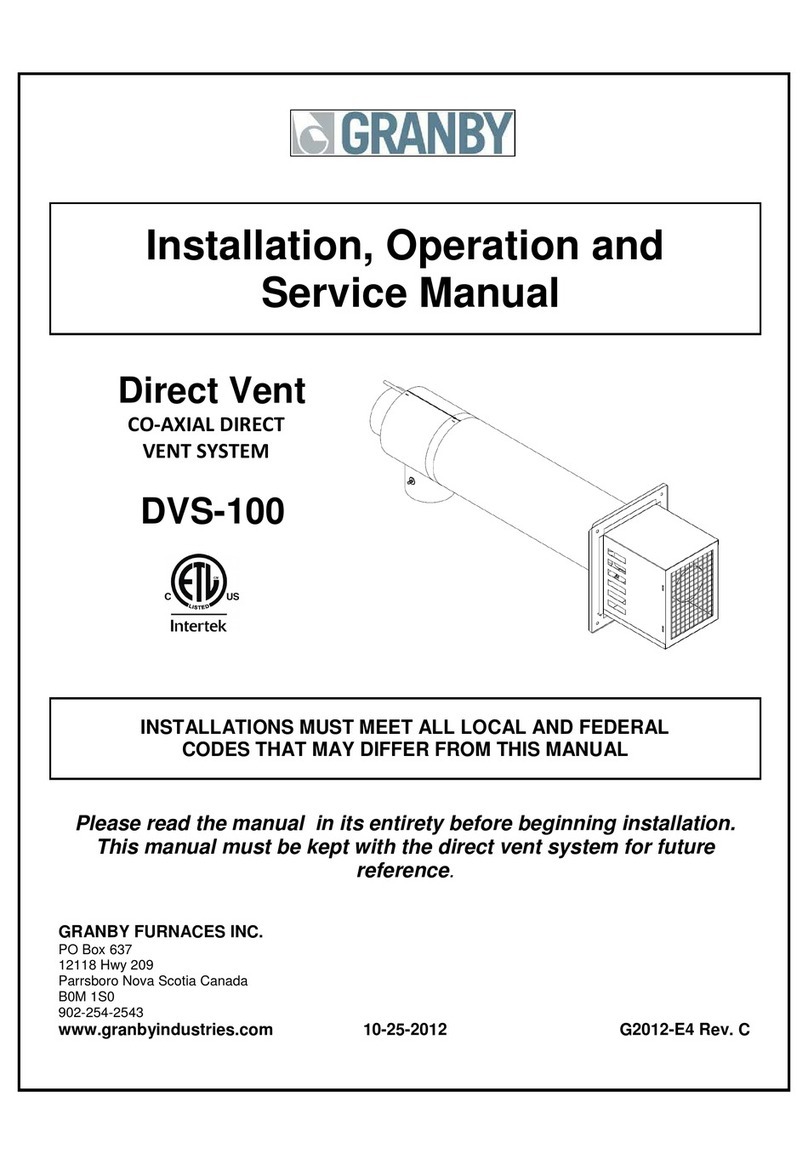
Granby
Granby DVS-100 Installation, operation and service manual

Caple
Caple Ceramica CR700 instruction manual

THERMEx
THERMEx INTEGRO PREMIUM instructions
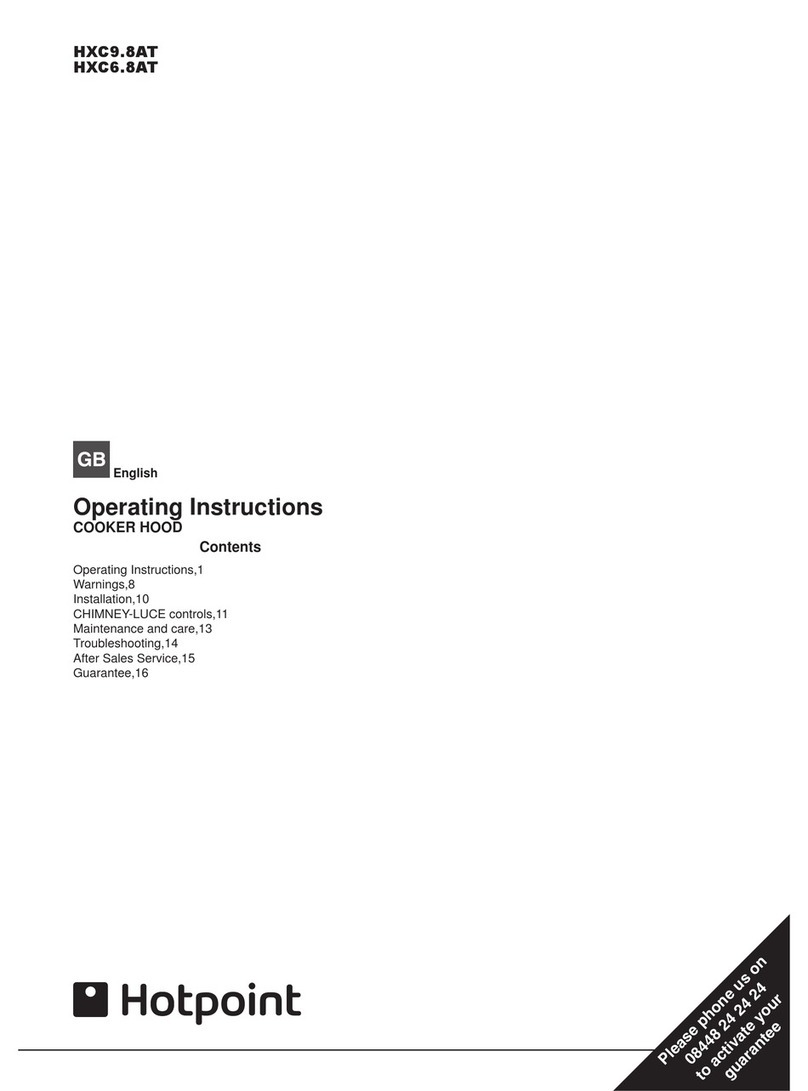
Hotpoint
Hotpoint HXC9.8AT operating instructions




